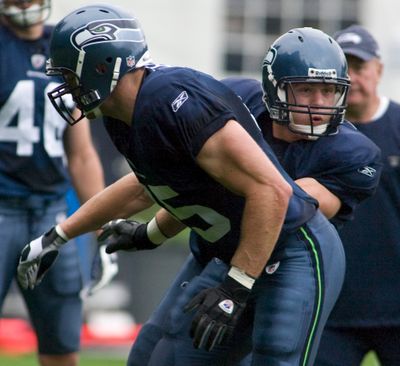Perfect mentality
Seattle rookie Carlson proves to be one quick study

KIRKLAND, Wash. – Long before he played basketball against LeBron James, before he won a state championship, before he became a starter for one of the nation’s most storied college football programs, John Carlson showed his most important athletic attribute at a young age.
“He probably wouldn’t want me to say this, but he was quite a Lego builder,” John Carlson Sr. said of his youngest son’s favorite hobby as a 5- and 6-year-old. “He could build some things with Lego’s that would make you say: ‘Wow, how can a kid do that?’ ”
For hours at a time, Junior would pore over his Lego sets, studying them as if he were trying to solve a puzzle.
It can be said that John Carlson Jr. attacks football the same way. While many others play the game for fun, the Seattle Seahawks’ new tight end approaches it as if it were a mathematical problem.
As John Sr. said of the boy who would go on to become a second-round draft pick: “He loves to learn.”
Carlson’s ability to pick things up quickly is what might make him the first rookie tight end in franchise history to start an opener.
Ever since Carlson was selected in the second round of the April draft, the 24-year-old Minnesota native has been tackling the Seahawks’ offense with the same ferocity that the honor student approached his schoolwork.
“Sometimes you get guys that can figure out the (text)book stuff, but they get on the field and don’t have the instincts,” tight ends coach Jim Lind said. “That’s not John. He studies, and he has good instincts to go with it. He’s very conscientious and wants to do it right. Those things make for a good formula.”
John Carlson Sr. said that his son was always pretty dedicated to his studies, all the way back to grade school. His drive as an athlete really hit Carlson Sr. during his son’s junior year at Litchfield (Minn.) High School.
Carlson Sr., the school’s varsity basketball coach, got so frustrated with his son at one practice that he snapped at him.
“I told him he was the worst passer I’d ever seen in my entire life,” said Carlson Sr., who also coached tennis and was an assistant on the Litchfield football staff. “From that day forward, he became one of the best passers I ever saw. He said: ‘If that’s what he thinks, I’ll show him.’ ”
Carlson Jr. went on to become an all-state basketball player who led his team to a state title and was a finalist for the McDonald’s All-America team.
During the summer between Carlson’s sophomore and junior year, he played on a traveling all-star team that competed against James’ summer-league team at a national tournament.
Because his 6-foot-5 frame was not ideal for the NBA, Carlson turned his attention toward football. He accepted a scholarship at Notre Dame and quickly learned how different the college level would be.
At Litchfield, Carlson only had about eight pass patterns. Under Tyrone Willingham’s West Coast-like system at Notre Dame, there could be as many as eight variations on a given play.
“It wasn’t until college that I realized you really have to sit down and prepare yourself mentally – sometimes more so than physically,” he said. “… The first time I looked at my (Notre Dame) playbook, it was eye-opening for me. In high school, I didn’t have to make all these reads and adjustments based on the defense. I had one job to do, and that’s what I did – block this way, or run this route.”
When former New England Patriots offensive coordinator Charlie Weis came in before Carlson’s junior season, bringing with him a pro-style offense, the studying continued.
But Carlson mastered that system as well.
The Seahawks have already seen what a quick study Carlson can be.
During an eight-day minicamp in June, he pored over the playbook and took so many notes that he filled up an entire spiral notebook.
When the minicamp closed, and Carlson had to return his playbook, he spent a good part of the next six weeks flipping pages in his notebook, over and over again.
“I had a lot to study,” he said. “The one thing I will say is that there’s a difference between knowing it on paper and doing it on the field. On the field, you really don’t have time to think.”